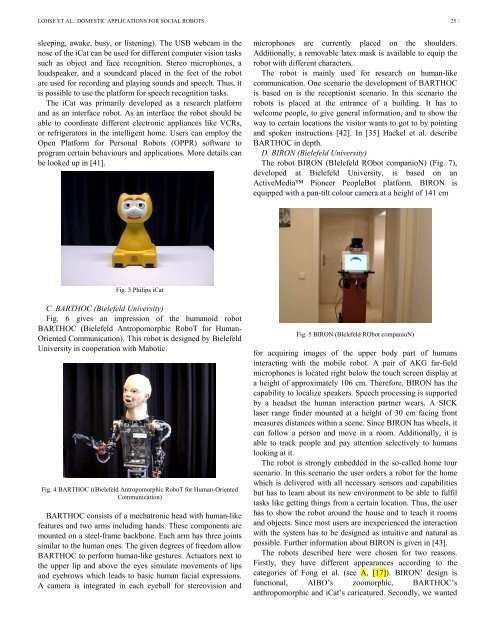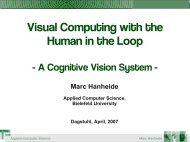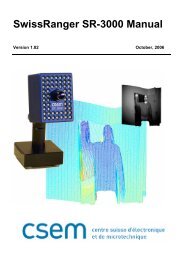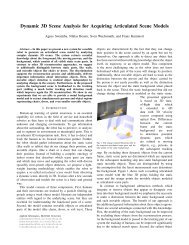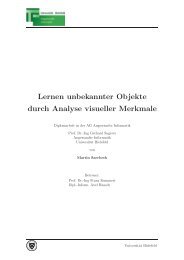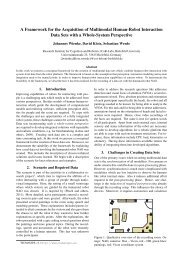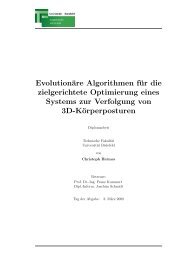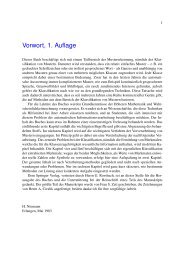Domestic Applications for Social Robots - Journal of Physical Agents
Domestic Applications for Social Robots - Journal of Physical Agents
Domestic Applications for Social Robots - Journal of Physical Agents
You also want an ePaper? Increase the reach of your titles
YUMPU automatically turns print PDFs into web optimized ePapers that Google loves.
LOHSE ET AL.: DOMESTIC APPLICATIONS FOR SOCIAL ROBOTS 25<br />
sleeping, awake, busy, or listening). The USB webcam in the<br />
nose <strong>of</strong> the iCat can be used <strong>for</strong> different computer vision tasks<br />
such as object and face recognition. Stereo microphones, a<br />
loudspeaker, and a soundcard placed in the feet <strong>of</strong> the robot<br />
are used <strong>for</strong> recording and playing sounds and speech. Thus, it<br />
is possible to use the plat<strong>for</strong>m <strong>for</strong> speech recognition tasks.<br />
The iCat was primarily developed as a research plat<strong>for</strong>m<br />
and as an interface robot. As an interface the robot should be<br />
able to coordinate different electronic appliances like VCRs,<br />
or refrigerators in the intelligent home. Users can employ the<br />
Open Plat<strong>for</strong>m <strong>for</strong> Personal <strong>Robots</strong> (OPPR) s<strong>of</strong>tware to<br />
program certain behaviours and applications. More details can<br />
be looked up in [41].<br />
Fig. 3 Philips iCat<br />
C. BARTHOC (Bielefeld University)<br />
Fig. 6 gives an impression <strong>of</strong> the humanoid robot<br />
BARTHOC (Bielefeld Antropomorphic RoboT <strong>for</strong> Human-<br />
Oriented Communication). This robot is designed by Bielefeld<br />
University in cooperation with Mabotic.<br />
Fig. 4 BARTHOC ((Bielefeld Antropomorphic RoboT <strong>for</strong> Human-Oriented<br />
Communication)<br />
BARTHOC consists <strong>of</strong> a mechatronic head with human-like<br />
features and two arms including hands. These components are<br />
mounted on a steel-frame backbone. Each arm has three joints<br />
similar to the human ones. The given degrees <strong>of</strong> freedom allow<br />
BARTHOC to per<strong>for</strong>m human-like gestures. Actuators next to<br />
the upper lip and above the eyes simulate movements <strong>of</strong> lips<br />
and eyebrows which leads to basic human facial expressions.<br />
A camera is integrated in each eyeball <strong>for</strong> stereovision and<br />
microphones are currently placed on the shoulders.<br />
Additionally, a removable latex mask is available to equip the<br />
robot with different characters.<br />
The robot is mainly used <strong>for</strong> research on human-like<br />
communication. One scenario the development <strong>of</strong> BARTHOC<br />
is based on is the receptionist scenario. In this scenario the<br />
robots is placed at the entrance <strong>of</strong> a building. It has to<br />
welcome people, to give general in<strong>for</strong>mation, and to show the<br />
way to certain locations the visitor wants to got to by pointing<br />
and spoken instructions [42]. In [35] Hackel et al. describe<br />
BARTHOC in depth.<br />
D. BIRON (Bielefeld University)<br />
The robot BIRON (BIelefeld RObot companioN) (Fig. 7),<br />
developed at Bielefeld University, is based on an<br />
ActiveMedia Pioneer PeopleBot plat<strong>for</strong>m. BIRON is<br />
equipped with a pan-tilt colour camera at a height <strong>of</strong> 141 cm<br />
Fig. 5 BIRON (BIelefeld RObot companioN)<br />
<strong>for</strong> acquiring images <strong>of</strong> the upper body part <strong>of</strong> humans<br />
interacting with the mobile robot. A pair <strong>of</strong> AKG far-field<br />
microphones is located right below the touch screen display at<br />
a height <strong>of</strong> approximately 106 cm. There<strong>for</strong>e, BIRON has the<br />
capability to localize speakers. Speech processing is supported<br />
by a headset the human interaction partner wears. A SICK<br />
laser range finder mounted at a height <strong>of</strong> 30 cm facing front<br />
measures distances within a scene. Since BIRON has wheels, it<br />
can follow a person and move in a room. Additionally, it is<br />
able to track people and pay attention selectively to humans<br />
looking at it.<br />
The robot is strongly embedded in the so-called home tour<br />
scenario. In this scenario the user orders a robot <strong>for</strong> the home<br />
which is delivered with all necessary sensors and capabilities<br />
but has to learn about its new environment to be able to fulfil<br />
tasks like getting things from a certain location. Thus, the user<br />
has to show the robot around the house and to teach it rooms<br />
and objects. Since most users are inexperienced the interaction<br />
with the system has to be designed as intuitive and natural as<br />
possible. Further in<strong>for</strong>mation about BIRON is given in [43].<br />
The robots described here were chosen <strong>for</strong> two reasons.<br />
Firstly, they have different appearances according to the<br />
categories <strong>of</strong> Fong et al. (see A, [17]). BIRON’ design is<br />
functional, AIBO’s zoomorphic, BARTHOC’s<br />
anthropomorphic and iCat’s caricatured. Secondly, we wanted


